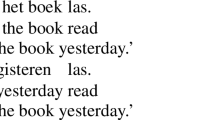Abstract
Some Chinese sentences allow a subject to take a full subject-predicate structure as its Predicate. The first subject is called “main subject” or “non-subject topic” (NS-topic) as distinct from the subject in the subject-predicate configuration. Previous studies mainly focus on the syntactic and semantic relations between the NS-topic and other components in the sentence. Not many researchers observe the functions of such elements in discourse. Based on a corpus of Mandarin conversations, we first calculate the occurrences of NS-topics and then examine their functions in sentences and in discourse. Our data show that four groups of NS-topics are prominent in conversations, namely, 1) modifiers of the subject, 2) temporal, spatial or conditional adverbials, 3) inverted objects, and 4) dangling topics. All the four groups of NS-topics have special discoursal functions, as lexical cohesive devices, as responses to alternative questions, or as local episodic topics in extended utterances.
Access this chapter
Tax calculation will be finalised at checkout
Purchases are for personal use only
Similar content being viewed by others
Notes
- 1.
- 2.
We followed the transcription conventions of Eggins and Slade [22]: T is for turn; here T29 refers to the 29th turn in the extract; labels in capital letter indicate the speaker identification; letters a, b, c, etc. mark the moves in one turn.
Abbreviations
- 1SG:
-
first person singular
- 2SG:
-
second person singular
- 3SG:
-
third person singular
- ASP:
-
aspect maker
- MEAS:
-
measure
- NEG:
-
negation
- TPART:
-
topic particle
- POSS:
-
possessive
References
Chao, Y.R.: A Grammar of Spoken Chinese. The Commercial Press, Beijing (2011)
Zhu, D.X.: Notes on Grammar. The Commercial Press, Beijing (1982)
Yuan, Y.L.: Topicalization and grammatical relations. Stud. Chin. Lang. 4, 241–254 (1996)
Shen, J.X.: On minor sentence and flowing sentences in Chinese: in commemoration of the 120th birthday of Yuen Ren Chao. Stud. Chin. Lang. 5, 403–415 (2012)
Chen, G.H., Wang, J.G.: Unmarked non-subject topics in Chinese. Chinese Teach. World. 3, 310–323 (2010)
Li, C.N., Thompson, S.A.: Subject and topic: a typology of language. In: Li, C.N., (ed.) Subject and Topic, pp. 457–489. Academic Press, New York (1976)
Li, C.N., Thompson, S.A.: Mandarin Chinese: A Functional Reference Grammar. University of California Press, Berkeley (1981)
Shi, D.X.: Topic and topic-comment constructions in Mandarin Chinese. Language 76(2), 383–408 (2000)
Pan, H.H., Hu, J.H.: A semantic-pragmatic interface account of (dangling) topics in Mandarin Chinese. J. Pragmat. 40, 1966–1981 (2008)
Chen, P.: Pragmatic interpretations of structural topics and relativization in Chinese. J. Pragmat. 26, 389–406 (1996)
Li, E.-H.: A Systemic Functional Grammar of Chinese: A Text-Based Analysis. Continuum, London (2007)
Fang, Y.: A study of topical theme in Chinese: an SFL perspective. In: Webster, J.J. (ed.) Meaning in Context: Implementing Intelligent Application of Language Studies, pp. 84–114. Continuum, London (2008)
Gao, Y.M., Lyv, G.Y.: Marked theme in spoken Chinese: a discourse semantics perspective. J. World Lang. 6(1–2), 46–69 (2020)
Xu, L.J., Liu, D.Q.: Topic: Structural and Functional Analysis. Shanghai Education Press, Shanghai (2007)
Chafe, W.: Giveness, contrastiveness, definiteness, subject, topic, and point of view. In: Li, C.N. (ed.) Subject and Topic, pp. 25–55. Academic Press, New York (1976)
Xu, L.J., Langendoen, D.T.: Topic structures in Chinese. Language 61(1), 1–27 (1985)
LaPolla, R.: Chinese as a topic-comment (not topic-prominent and not SVO) language. In: Xing, J. (ed.) Studies of Chinese Linguistics: Functional Approaches, pp. 9–22. Hong Kong University Press, Hong Kong (2009)
Du Bois, J.W., Schuetze-Coburn, S., Cumming, S., Paolino, D.: Outline of discourse transcription. In: Edwards, J. A., Lampert, M. D. (eds.) Talking data. Transcription and Coding in Discourse Research. Lawrence Erlbaum, Hillsdale, pp. 45–89 (1993)
Song, R.: On generalized-topic-based Chinese discourse structure. In: Proceedings of CIPS-SIGHAN Joint Conference on Chinese Language Processing, pp. 23–33 (2010)
Martin, J.R., Rose, D.: Working with Discourse: Meaning Beyond the Clause, 2nd edn. Continuum, London (2007)
Chen, J., Gao, Y.: Is Chinese topic-prominent language? Foreign Lang. Teach. 5, 11–14 (2000)
Eggins, S., Slade, D.: Analysing Casual Conversation. Cassell, London (1997)
Halliday, M.A.K., Hasan, R.: Cohesion in English. Longman, London (1976)
Xie, X.: Unmarked responses to yes/no and wh-questions in Chinese natural conversations. In: Fang, M., Cao, H.L. (eds.) Interactional Linguistics and Chinese Language Studies, vol. 2, pp. 248–268. Social Sciences Academic Press, Beijing (2018)
van Dijk, T.A.: Episodes as units of discourse analysis. In: Tannen, D. (ed.) Analyzing Discourse: Text and Talk, pp. 177–195. Georgetown University Press, Georgetown (1981)
Her, O.S.: Topic as a grammatical function in Chinese. Lingua 84, 1–23 (1991)
Author information
Authors and Affiliations
Corresponding author
Editor information
Editors and Affiliations
Rights and permissions
Copyright information
© 2022 Springer Nature Switzerland AG
About this paper
Cite this paper
Gao, Y., Lyu, G. (2022). Functions of Non-subject Topics in Mandarin Conversations. In: Dong, M., Gu, Y., Hong, JF. (eds) Chinese Lexical Semantics. CLSW 2021. Lecture Notes in Computer Science(), vol 13249. Springer, Cham. https://doi.org/10.1007/978-3-031-06703-7_25
Download citation
DOI: https://doi.org/10.1007/978-3-031-06703-7_25
Published:
Publisher Name: Springer, Cham
Print ISBN: 978-3-031-06702-0
Online ISBN: 978-3-031-06703-7
eBook Packages: Computer ScienceComputer Science (R0)




